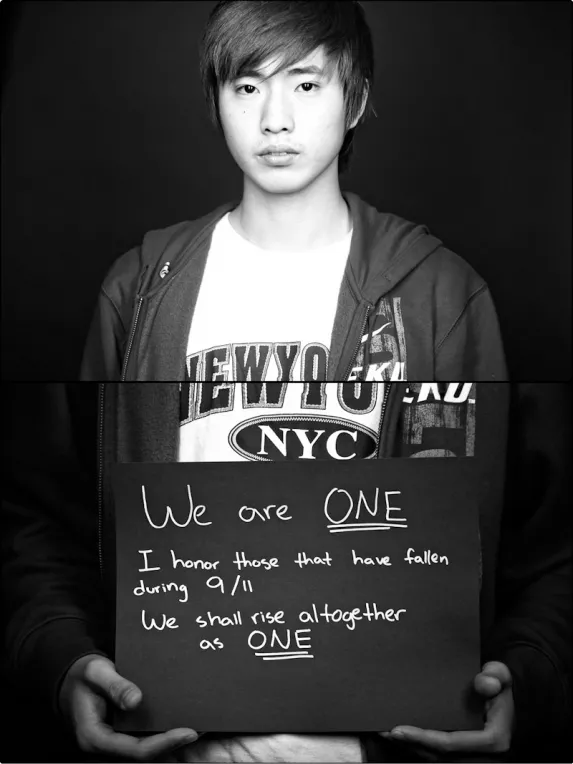
How do you commemorate the tenth anniversary of the darkest day of our generation? We've struggled with this question over the past few weeks. Most of the students at our Universities were far to young to appreciate the magnitude of September 11th, yet their world is largely shaped by the effects of it. The rest of us remember it far to vividly.
Chris Radcliffe at Eastern Kentucky University came up with a project that was not only reverential to losses of that day, but also showed the hope of moving forward. Please visit the piece on the EKU Photo blog at: http://www.eku.edu/photo/911-looking-back-then-moving-forward
Bong Han Lee - Photo by Chris Radcliffe/EKU
I asked Chris if he would answer a few questions about the project, Q and A follows below:
Can you explain a little bit more about your concept, how did you come up with it?
It is not at all an original idea. I've seen variations of this used for different and similar purposes. There's book on my shelf called Love Letters to the South that I'm sure was my subconscious inspiration. In fact, I eventually used that book to help explain the idea to my superiors. That book is a collection of portraits of celebrities shown alongside letters they wrote to the victims of Katrina. The thought for this photo project occurred to me just a couple weeks (maybe less) before I shot it. When I remembered the Love Letters book I was worried my idea would be too close to it and I was discouraged for about a day. Ultimately, I decided that I could put my own spin on it. My intention was to honor the memory of that day... and this is the way I wanted to do it. It was an early decision to shoot two horizontal images and somehow show them together. The main reason behind this was that these photos would end up and 800 pixels wide on a webpage and I was worried if I did it all in one shot people would have trouble reading the messages. A problem with that concept was that I never fully decided how to join the two images before I started shooting. It wasn’t until the editing process that I made that determination. Looking back I would have photographed them a little differently. During the (last minute) planning I was thinking about shooting many different “sectional” images of the subjects and make one of those haphazard collage looking portraits. If I had more time to edit or another shot at the whole thing I might give that a try. When it came to editing the take I realized that I could still accomplish that look to a small degree with the two images so I tried to match them up in that haphazard collage fashion. It definitely worked better on some than others. I lit them with two gridded strip boxes positioned pretty close together to create catch lights in the form of the number 11 or the Two Towers (depending on how you see it). Obviously, I overexposed a bit. I shot two 5d mk2’s. The portrait camera had 50mm f/1.2 and the message camera had a 24-105mm f/4.
Isaias Martinez - Photo by Chris Radcliffe/EKU
How did you choose people your subjects?
This was the hardest decision to make. Since I knew it’s home would be the photo blog, I didn’t want to have too many images. I definitely didn’t want to create a situation in which I would have to pick only the “best” images to show. With that in mind, I concluded it would be best to have a smaller sample to work with. I thought, “Okay, let’s just set it up and invite people to be a part of it as they walk by (I was in the Library).” It became evident late in the game that idea wouldn’t work well either. So, the night before I sent a mass email to just about all the faculty and staff and students I had in my contact lists asking them to be a part of it. I wanted about 30 or so and I got right about that number. I couldn’t have hoped for a better representation given the time frame. The most important thing for me was to have a diverse sample of representation. I think we did well with that.
Jessica Mitchell - Photo by Chris Radcliffe/EKU
What was the reaction to your project?
The reaction was very positive (as far as I know). I received many emails thanking me for the effort and the tribute. The point was to give the EKU community a platform upon which to express our feelings. Perhaps the most rewarding thing for me was to relive the experience through the eyes of the subjects as they struggled to find words suitable enough to express their feelings. Honestly, I think I got more out of it than anyone. It was a very special opportunity to share those memories... no matter how hard it was to look back.
Chris Radcliffe has been a University Photographer at Eastern Kentucky University since 2004. His work can be seen on the EKU Photo Blog at http://www.eku.edu/photo